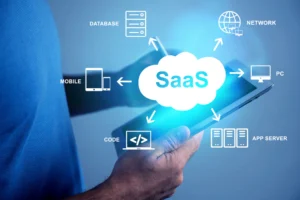Stop burning cash on ads. Here’s how smart SaaS founders are building predictable revenue engines through strategic SEO.
Your competitor just raised $50 million and is flooding every digital channel with ads. Meanwhile, you’re bootstrapping your way to profitability, watching your customer acquisition costs climb higher each month.
However, here’s what they don’t know: while they’re burning venture capital on expensive ads, you can quietly build something more sustainable—a search engine optimization strategy that turns Google into your 24/7 salesperson.
Welcome to SaaS SEO, where smart founders are generating qualified leads at 50-80% lower cost than paid advertising.
What Makes SaaS SEO Different (And Why Generic Advice Fails)
SaaS SEO isn’t regular SEO. Instead, your customers don’t search for “buy CRM software now” and immediately purchase. Rather, they start with problems: “how to manage customer relationships better” or “why am I losing sales leads?”
The SaaS buyer journey is fundamentally different:
- First, sales cycles span 3-12 months
- Additionally, multiple stakeholders research solutions
- Moreover, trust and authority matter more than features
- Finally, buyers compare 5-10 alternatives before deciding
Consequently, this is why e-commerce SEO tactics fall flat for software companies. Therefore, you need a strategy built for how B2B buyers actually research and purchase software.

The Real ROI Numbers Your CFO Needs to See
Customer Acquisition Cost: While Google Ads can cost $200-800 per SaaS customer, organic search typically delivers customers at 60% lower cost.
Quality Over Quantity: Furthermore, organic customers convert 3x better than paid traffic because they’ve already done their research.
Compound Growth: Unlike ads that stop when you pause campaigns, SEO compounds monthly. For example, Zapier’s 2,900+ integration pages now drive millions in recurring revenue—content they created once but ranks forever.
The 3-Stage SaaS Customer Search Journey
Your SEO strategy must meet customers at every research stage. Therefore, let’s break down each phase:
Stage 1: Problem Awareness
What they search: “Why does [process] take so long?” or “How to reduce [pain point]”
Your content opportunity: Educational guides addressing real business problems
Example: Instead of “CRM features,” create “Why 67% of sales leads disappear (and how to fix it)”
Stage 2: Solution Research
What they search: “Best [tool type] for [use case]” or “[Process] software comparison”
Your content opportunity: Comparison guides and tool evaluations
Example: “Best project management software for remote teams: 2025 comparison”
Stage 3: Vendor Evaluation
What they search: “[Your product] vs [competitor]” or “[Competitor] alternatives”
Your content opportunity: Direct comparisons showcasing your advantages
Example: “Slack vs Microsoft Teams: Which saves more time for growing companies?”
The 4-Step SaaS SEO Framework That Converts
Now, let’s dive into the strategic framework that actually drives results:
1. Strategic Keyword Research (Beyond Search Volume)
Most SaaS companies chase high-volume keywords that don’t convert. However, smart founders target buyer intent keywords.
Focus on problem-solving queries:
- “How to [solve customer problem]” (high traffic, early-stage buyers)
- “[Tool category] for [specific use case]” (medium traffic, qualified leads)
- “[Your product] vs [competitor]” (lower traffic, high-intent prospects)
The long-tail advantage: Instead of competing for “CRM” (impossible), target “CRM for real estate teams under 50 people.” As a result, you’ll face less competition and achieve higher conversion rates.
2. Content That Nurtures AND Converts
The biggest SaaS content mistake? Creating blog posts and expecting immediate trials. However, your readers aren’t ready to buy—they’re still learning.
The conversion-focused approach:
- Educational content + soft CTAs: “Want to see this in action? Here’s a free template.”
- Strategic internal linking: Guide readers from problem-aware to product-aware content
- Value-first lead magnets: Offer genuine resources, not product demos
Content types that actually drive revenue:
- Comparison content: Captures high-intent traffic researching solutions
- Alternative pages: Intercepts competitor searches
- Industry reports: Builds authority and earns backlinks naturally
- Customer success stories: Demonstrates real ROI to prospects
3. Technical SEO Foundations
Amazing content won’t rank if your technical foundation is broken. Therefore, focus on these non-negotiable requirements:
Site Speed: Under 3 seconds load time. Use GTmetrix to identify and fix speed issues.
Mobile Optimization: Since 68% of B2B research happens on mobile devices, your site must work perfectly on phones.
Strategic Site Architecture: Create clear paths from educational content to product pages.
Internal Linking Strategy: Help Google understand your most important pages through strategic linking.
4. Authority Building Through Smart Link Building
Links remain a top-3 ranking factor, especially for competitive SaaS keywords. However, here’s what actually works:
Digital PR that builds authority:
- First, publish original industry research (others will reference and link to it)
- Next, share expert commentary on industry trends
- Finally, create guest content on publications your customers read
Resource-based link building:
- Find “[Your category] tools” resource pages
- Then, pitch inclusion with genuine value proposition
Advanced SaaS SEO Tactics for Competitive Advantage
Programmatic SEO: Scale Without Manual Work
Companies like Ahrefs create thousands of pages using data and templates. Specifically:
- Integration pages: “[Tool A] + [Tool B] setup guide”
- Comparison matrices: “[Tool A] vs [Tool B] vs [Tool C]”
- Industry-specific pages: “[Your tool] for [industry] teams”
The key: Each page must provide unique value, not just keyword variations.
Video SEO: The Untapped SaaS Opportunity
Google increasingly shows video results for software searches. Therefore, smart SaaS companies are capturing this traffic:
- Product walkthrough videos
- Customer success story videos
- Tutorial and how-to content
Optimization essentials: Include transcripts, optimize titles/descriptions, and embed in relevant blog posts.
Measuring SaaS SEO Success
Track metrics that actually impact revenue. Specifically, focus on:
SEO Performance:
- Organic traffic growth (month-over-month)
- High-intent keyword rankings
- Domain authority progression
Business Impact:
- Free trials from organic search
- Customer acquisition cost from SEO
- Revenue attribution from organic channels
Common SaaS SEO Mistakes Killing Your Growth
Mistake #1: Only Targeting Bottom-Funnel Keywords
The fix: Instead, create content for every buyer journey stage, not just “ready to purchase” searches.
Mistake #2: Ignoring Search Intent
The fix: First, analyze what’s currently ranking for your keywords. Then, match content format to user expectations.
Mistake #3: Creating Content Without Distribution
The fix: Promote through email, social, and partnerships to get initial ranking momentum.
Your 90-Day SaaS SEO Quick-Start Plan
Month 1: Foundation
- First, complete technical SEO audit and fix critical issues
- Next, research buyer journey keywords
- Finally, analyze top competitor content strategies
2: Content Creation
- Initially, develop 4-6 pillar pieces targeting main topics
- Then, create supporting cluster content
- Subsequently, implement strategic internal linking
Month 3: Promotion and Authority
- First, launch content promotion campaigns
- Next, begin strategic outreach for backlinks
- Finally, set up comprehensive tracking
The Future of SaaS SEO: What’s Changing in 2025
AI-Powered Search Results: Google’s AI Overviews are changing search behavior. Therefore, win by creating authoritative, comprehensive content that AI systems reference.
Experience-First Rankings: Additionally, Google rewards content demonstrating first-hand expertise. Include author credentials, real case studies, and customer results.
Voice Search Growth: Furthermore, optimize for conversational queries and question-based searches as voice search adoption accelerates.
Start Building Your SEO Revenue Engine Today
SaaS SEO isn’t a quick fix—it’s a compound growth strategy that becomes more profitable over time. While competitors burn cash on ads, you can build sustainable competitive advantages through organic search dominance.
Your next three actions:
- First, audit existing content using the buyer journey framework
- Then, identify five high-intent keywords your ideal customers search for
- Finally, create one problem-solving piece that genuinely helps without pitching your product
Ultimately, your competitors are probably still throwing money at paid ads while ignoring organic search. That’s your competitive opportunity.
SaaS SEO FAQs
Q: How long until we see SaaS SEO results? A: Initially, you’ll see improvements within 3-4 months, with significant growth by months 6-12. Overall, SaaS SEO is a long-term strategy with compound returns.
Q: What should we budget for SaaS SEO? A: Typically, successful SaaS companies invest 15-25% of marketing budget in SEO, ranging from $5,000-$50,000+ monthly based on company size.
Q: Can small SaaS companies compete with enterprise competitors? A: Absolutely. Instead, focus on long-tail keywords, niche problems, and more comprehensive content than larger competitors’ generic resources.
Q: How do we measure SEO ROI accurately? A: Track organic traffic growth, trial signups from search, customer acquisition cost from SEO, and revenue attribution using Google Analytics and CRM integration.
Q: What’s the biggest SaaS SEO mistake? A: Creating content without understanding buyer intent. Rather than chasing high search volume, focus on keywords your ideal customers use during research.
Ready to build your organic growth engine? SpaceLoad helps B2B SaaS companies dominate search results through strategic SEO that drives qualified leads and sustainable revenue growth.



